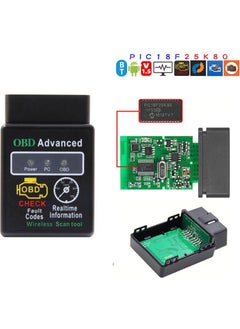Free & Easy Returns
Best Deals
ELM27 OBD2 BLUETOOTH VEHICLE DIAGNOSIS DEVICE
Product features :
Detect and clear malfunctions and error codes in your vehicle and turn off the fault light.
provides.
It has Pic18f25k80 chip.
Microcontrollers such as PIC18F25K80 are used in some applications such as vehicle fault detection.
benefits:
High Performance Processor:
has. This ensures fast and efficient data processing, which means that data can be quickly retrieved during fault diagnosis.
allows it to be processed and analyzed in a way that
Extensive Connection Options:
It has multiple serial communication and digital I/O pins that support UART, etc.). This is from the vehicle
connecting to different sensors or communication interfaces to read incoming data
makes it easier.
Low Power Consumption:
Low-power microcontrollers such as PIC18F25K80 can be used in low power diagnostic devices.
It meets power consumption requirements and prevents unnecessary discharge of the vehicle's battery.
Flexible Programming Capabilities:
and can be customized to fit different vehicle makes and models. This is a variety of tools
It provides the flexibility needed to process different incoming data formats.
Version is 1.5.
The software is compatible with all platforms.
Works with all OBD-II compliant vehicles.
Wireless (Bluetooth) 5~10meters.
Including software for Palm,PDA,Mobile,Windows PC,Smartphone.Support Android systerm.
iPhone is not compatible.
Read generic and manufacturer-specific diagnostic trouble codes and view their meanings
(More than 300 common code definitions in the database).
Clear trouble codes and turn off MIL ("Check Engine" light).
Display current sensor data, Engine RPM, Calculated Load Value, Coolant Temperature,
Fuel System Status,
Vehicle Speed, Short Term Fuel Trim. Long Term Fuel Terminus, Intake Manifold Pressure,
Timing Advance, Emmme Air,
Temperature, Airflow Rate, Absolute Throttle Position, Oxygen sensor voltages/short
future fuel trims,
Fuel System status, Fuel Pressure.
Support OBD-II protocols: ISO15765-4 (CAN), ISO14230-4 (KWP2000), ISO9141-2
TECHNICIAL SPECIFICATIONS :
- Current sensor data including display
- Calculated Load Value
- Coolant temperature
- Fuel System Status
- Vehicle speed
- Version 1.5
- Chip: Pic18f25k80
- Short Term Fuel Trim
- Long Term Fuel Trim
- Intake Manifold Pressure
- Timing Advance
- EmmmeAir Temperature
- Air Flow Rate
- Absolute Throttle Position
- Oxygen sensor voltages / associated short-term fuel coatings
- Fuel system status
- Fuel pressure
Follow Follow Multi Protocol:
ISO 9141-2 (5 baud init, 10.4 kBaud)
ISO 14230-4 KWP (5 baud init, 10.4 kBaud)
ISO 14230-4 KWP (fast start, 10.4 kBaud)
ISO 15765-4 CAN (11 bit ID, 500 kBaud)
ISO 15765-4 CAN (29 bit ID, 500 kBaud)
ISO 15765-4 CAN (11 bit ID, 250 kBaud)
ISO 15765-4 CAN (29 bit ID, 250 kBaud)
SAE J1850 PWM (41.6 kBaud)
SAE J1850 VPW (10.4 kBaud)
Supports the following software:
Torque (available for download from Android Market)
Scantool_net113win (Full Version)
EasyOBDII V2.2 (Full Version)
OBD2Spy (Demo Version)
ScanMaster-ELM (Demo Version)
WOBDCRAZY (Demo Version)
Is my vehicle OBD2 compatible?
American cars after 1996, European gasoline cars after 2001
(diesel after 2004) and Japanese cars after 2005 follow the OBDII standard.
It supports.
You can find out whether your vehicle is OBD compatible or not on the label on the engine.
You can check if this label says OBD II, EOBD or JOBD.
One thing you should pay attention to is that your vehicle must be OBD2 compatible, not OBD.
OBD compatible vehicles cannot be used with tools such as ElmScan.
How can I learn the OBD2 protocol of my vehicle?
You can ask the authorized service or do research on the internet.
Different protocols even for vehicles with the same model but different engines in the same year
may have been used.
| HS Code | 820600000000 |

